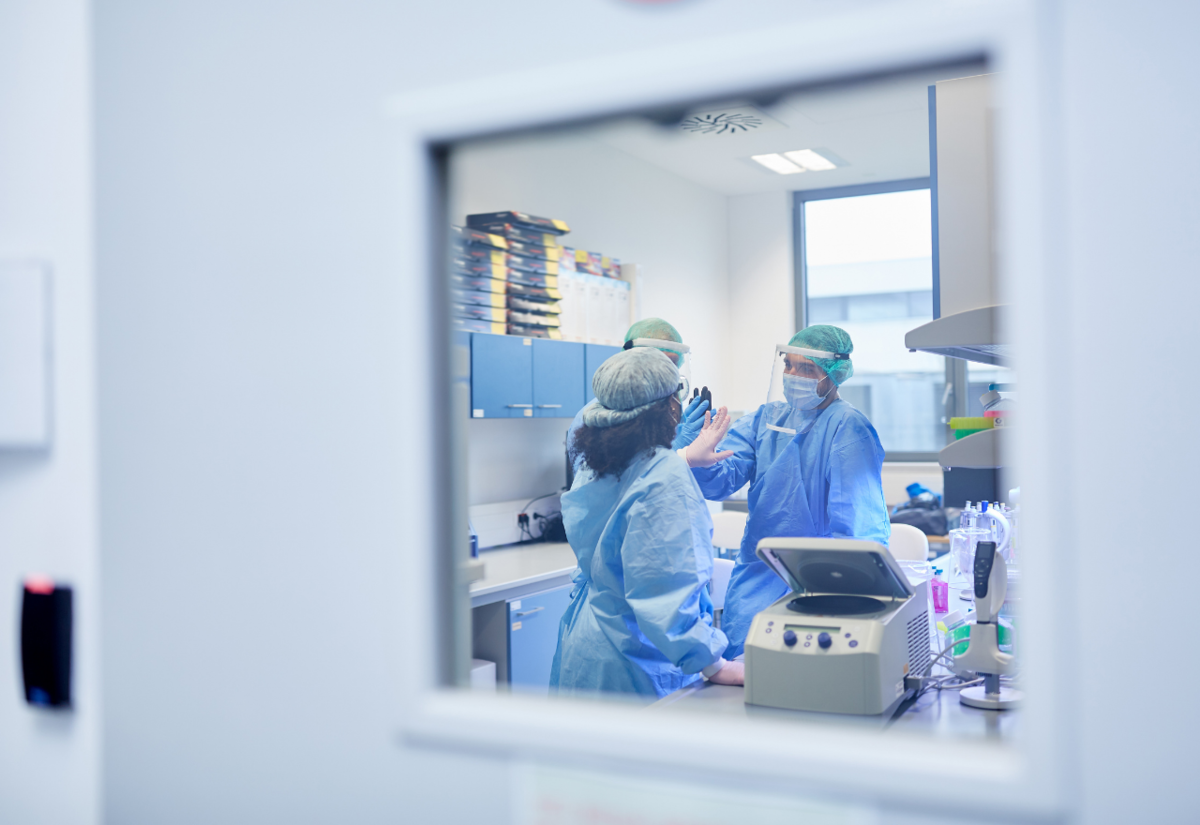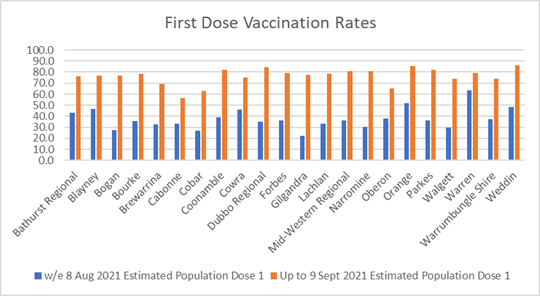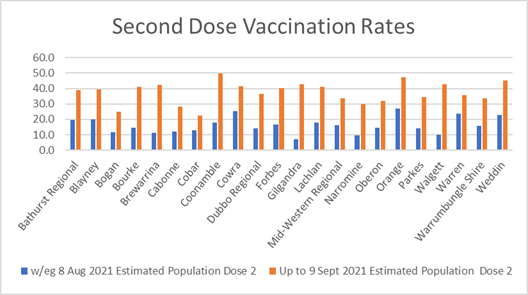WNSWLHD vaccination rate significantly improved over past month
Oliver Brown
14 September 2021, 7:54 AM
 Health workers across the WNSWLHD are celebrating a significant spike in vaccination intake across the district over the past month, with several LGAs now having more than 40 per cent of their populations fully vaccinated.
Health workers across the WNSWLHD are celebrating a significant spike in vaccination intake across the district over the past month, with several LGAs now having more than 40 per cent of their populations fully vaccinated. COVID-19 vaccination rates across the Western NSW Local Health District (WNSWLHD) are now among the most-improved in the state across the last four weeks.
The announcement came based on new data released by the state government on Tuesday 14 September, which showed vaccination rates skyrocketing across the region between Sunday 8 August and Thursday 9 September.
The news has been welcomed by WNSWLHD Chief Executive Scott McLachlan, who said he was proud to see there had been a spike across both Aboriginal and non-Aboriginal communities.
“We’ve seen the first-dose rate of COVID-19 vaccinations go from 17 per cent to 56 per cent for Aboriginal people and from 41 per cent to 82 per cent for non-Aboriginal people," Mr McLachlan said.
“The second-dose rate for Aboriginal people has gone from around seven per cent to almost 22 per cent, and from 20 per cent to more than 41 per cent for non-Aboriginal people.
“While we’ve still got a long way to go to reach that 80 per cent goal, the number of people with first doses on board puts us in a really good position."
The increase in vaccination intake between August and September has been recorded across all WNSWLHD LGAs. The below graphs show the difference over the past four weeks (courtesy of the state government).


Coonamble leading the way
According to the data, seven local government areas in the district, including Coonamble and Narromine, all have first dose rates over 80 per cent.
Coonamble also has the highest second-dose rate across the district at almost 50 per cent, while an additional nine LGAs, including Gilgandra, Walgett and Brewarrina, are above 40 per cent.
The most-improved LGA was Gilgandra, which recorded an increase of 54.6 per cent for first doses and almost 36 per cent for second doses. Many other LGAs across the district had also recorded significant spikes for both first and second doses.
Member for Barwon Roy Butler, who represents a large part of the Western Plains, also commended the LGAs in his district for being more open to vaccination over the past few weeks.
"The data shows that communities across the Western LHD are leading the way - for example the Coonamble first and second dose rate is very high which is a real credit to the community of Coonamble for getting on the front foot," Mr Butler said.
Mr Butler said the recent spike in vaccination rates was likely because of the state's supply of vaccine, particularly the Pfizer vaccine, significantly increasing in recent weeks.
He also pointed out plenty more was on the way, including the Moderna vaccine, which he said was better suited to the regions as it was not as dependent on cold temperatures as Pfizer, making them easier to transport.
Don't trust "old mate on social media"
Mr Butler said that while he had never been in favour of enforcing vaccines, preferring "more of a carrot than stick" approach he said it was important for anyone with doubts to seek advice from health professionals rather than social media.
"I find it bizarre that we normally put a lot of trust in GPs and health professionals but when it comes to COVID vaccines, some people decide to do the opposite and just trust old mate on social media - we need to make sure we're asking the right people the right questions," he said.
"It is also important to recognise that there are some people who can't get a vaccination for legitimate medical reasons, and it is possible for them to get an exemption from certain medical professionals."
Information about these exemptions, including how to know if you are eligible and which health providers can provide them, can be found here.
Despite the improvement in the region's vaccination rates, Mr McLachlan encouraged anyone who hasn't been vaccinated yet to seek out any opportunity to do so, as well as still following all current COVID restrictions in their respective LGAs and presenting for regular testing if they display any signs or symptoms for the virus.
He also said there was still plenty of room for improvement in LGAs like Cobar, Cabonne and Oberon, which have the lowest rate of first doses.
"We can’t afford to see any communities left behind - a lot of us travel to see friends and family, or for work or events, so we need to work together to tackle this threat,” he said.